#Mark Kilroy
Explore tagged Tumblr posts
Text


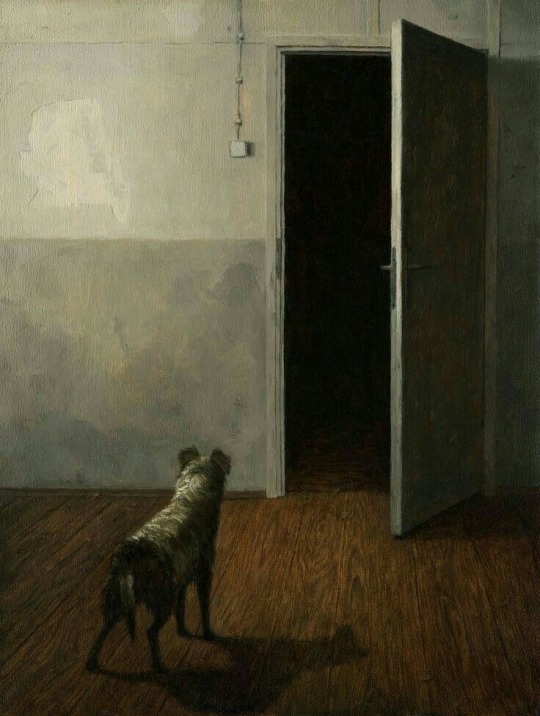






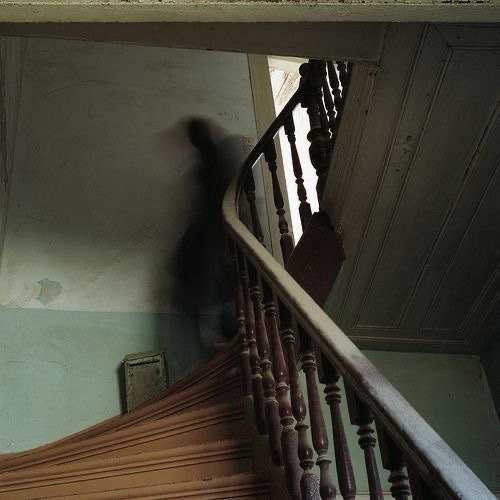








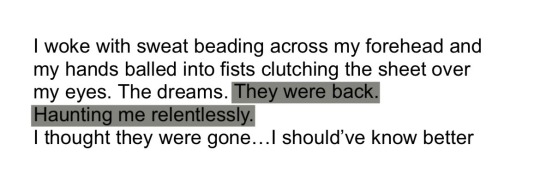

MY SLEEPS ARE CURSED WITH NIGHTMARES
“Beautiful Redemption” (Caster Chronicles series), by Kami García and Margaret Stogl; // “Scrape” (Reveler series), by Erin Kellison; // “House of Leaves”, by Mark Z. Danielewski; // Stephen King; // “The Song of Achilles”, by Madaline Miller; // “Dead Toad Scrolls”, by Kilroy J. Oldster; // “Mockingjay” (The Hunger Games series), by Suzanne Collins; // “Watching you Without Me”, by Lynn Coady; // “Jack, Lucid Dreamer”, by David J. Naiman; // Nanette L. Avery; // Kimberly Brockman; // Anthony T. Hincks
#webweaving#web weaving#webweave#web weaves#nightmare#nightmares#nightmarecore#dreamcore#haunted#ghost and hauntings#haunting#scary#terror#aesthetic#poem#poetry#spilled ink#spilled poetry#spilled thoughts
245 notes
·
View notes
Note
read alan’s our evenings on your recc and loved it. started and finished the whole thing on a 15hr flight and felt so winded by the end ohmygod
Dearest ratty, I meant to reply to this with one of those "top 10 books of 2024" posts but then i realised I'd have to download cover pics and the whole shebang so i said I'd just write it all down.
So glad you loved Our Evenings - Hollinghurst is absolutely categorically one of my favourite authors of all time. I read The Folding Star at 14 and it informed my adolescence so strongly, and eventually brought me to huge introspection and an interrogation of my sexual and gender identity etc. (Fun fact, i met him and told him about reading it and he said, looking concerned, "weren't you a little young to be reading that" lol). Our Evenings, I think, is very different in tone to some of his earlier work - I love the focus on the female characters, the way he writes older women, the way he writes queer identities. It feels almost nostalgic even during the reading, which is odd and unsettling imo, and different to the immediacy of his other work.
It would have been my book of the year if it weren't for the fact that I read Henry Henry by Allen Bratton in 2024 and was FUNDAMENTALLY CHANGED so if you're looking for a rec then jot that down.
And to round out discussion of 2024 with my top 3, I think I'd have to go for Skippy Dies by Paul Murray. May be a cheat as it was a reread for me but i genuinely did not remember a single thing so it was as though I was reading it for the first time. Absolutely compulsively readable, epically whimsical, deeply disturbing, funny as fuck and poignant as hell. Loved it.
Others I read in 2024 (non-exhaustive list, i'm forgetting lots i'm sure): Ordinary Human Failings by Megan Nolan (this was great, much better than her first imo), Perilous Times by Thomas D Lee (i think fandom pals would love this, it was a great read - v funny and dark), Stranger's Child by Hollinghurst (reread, unreal), Pity by Andrew McMillan (really liked though felt it was a little flat - v poignant and delicate and lovely though), 2 x KJ Charles Secret Lives of Country Gentlemen (eh, I'm hit and miss on this author), Fourth Wing by Rebecca Yarros (i thought this was objectionably bad tbh - this doesn't always stop me reading and I did get to the end or v near, but it was def a hate read), Glorious Exploits by Ferdia Lennon (SUPERB, one of those books that's just as good if not better via audio), River Man by RB Croft (not sure what this was tbh i have no memory of it), The Mark and the Void by Paul Murray (my least fave of his but still a banger), Long Live Evil by Sarah Rees Brennan (i wanted to love this so badly but I found it muddled and the pacing a bit patchy unforch - when it's good it's good though), Wild Houses by Colin Barrett (this was a DNF though I do hope to go back to it, i think he's a great writer but this didn't quite hit for me at the time), Evenings and Weekends by Oisin McKenna (same), The Safekeep by Yael van der Wouden (ummm i thought this was really good in many ways - one of those books i like a lot when i look back on it, the overall tone of the book wasn't what i was expecting but it was really interesting and clever and feelsy, def one i'd rec despite it not being a favourite of me personally, if that makes sense?), She's Always Hungry by Eliza Clark (absolutely magnificent, again i would recommend listening to the audiobook for this one), Soldier Sailor by Claire Kilroy (DNF, deeply tedious and uninspired imo), Matrix by Lauren Groff (this one was just fine imo), then i did rereads of Maurice by EM Forster, Filthy Animals and Real Life by Brandon Taylor (my beloved, what i would not GIVE to be able to write like him), oh and I read The Pairing by Casey McQuiston (i thought this was fine? liked it more than the other ones, a bit heavy-handed but hey) and Broken Light by Joanne Harris which i thought was rubbish. I can't remember if last year was the year i also reread all the Sally Rooney books too but it might have been. Oh and Sword-Crossed by Freya Marske which alas was a DNF too iirc - this was a miss for me, it felt a tad clumsy and laboured in the world-building imo. But i'm not a romance reader so it's probably me and not the book, her fics are really excellent and she is a good writer.
I did start a goodreads to track my 2025 reading😬 so if anyone's on there and wants to be friends that would be lovely. i can offer a variety of three star reviews and lukewarm takes, none of which hold up to any scrutiny.
Current reads: in book-books I've just started The Diving Pool by Yoko Ogawa. On audible I'm just about to start Deviants by Santanu Bhattacharya (deeply excited). Libby has just offered me Onyx Flame or whatever it's called by Rebecca Yarros, which is weird because i would have thought it would be all booked up. But I might not end up reading it (see above for thoughts on book 1, and i haven't read book 2).
44 notes
·
View notes
Text
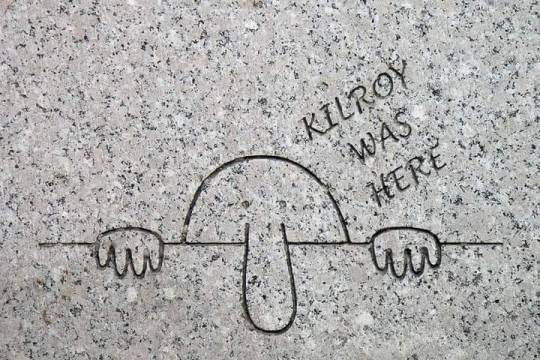
Kilroy Was Here: The Story Behind the Iconic WWII Graffiti
WHO WAS KILROY?
For many, especially those born between 1913 and 1950, the name "Kilroy" brings back a flood of memories. This piece of American history is immortalized in stone at the National War Memorial in Washington, DC, hidden away in a small alcove.
So, who was Kilroy?
In 1946, the American Transit Association sponsored a nationwide contest through its radio program, "Speak to America," to find the real Kilroy, offering a prize of a real trolley car. Almost 40 men claimed to be the genuine Kilroy, but only James Kilroy from Halifax, Massachusetts, provided the necessary evidence.
James Kilroy was a 46-year-old shipyard worker during WWII, employed as a checker at the Fore River Shipyard in Quincy. His job involved counting the rivets completed by the riveters, who were paid by the rivet. To prevent double counting, Kilroy marked the inspected rivets with semi-waxed lumber chalk. However, riveters would erase his marks to get paid twice.
To combat this, Kilroy began writing "KILROY WAS HERE" in large letters alongside his check-marks, eventually adding a sketch of a chap with a long nose peering over a fence. This made it difficult for the riveters to erase his marks, and soon, his graffiti began appearing on ships leaving the shipyard.
With the war in full swing, these ships often went unpainted, leaving Kilroy's markings visible to thousands of servicemen who boarded them. The troops, amused and intrigued by the mysterious graffiti, began spreading the "Kilroy was here" message across Europe and the South Pacific, claiming it was already there when they arrived.
Kilroy became a symbol of the U.S. service-men's presence, appearing in unlikely places such as atop Mt. Everest, the Statue of Liberty, the underside of the Arc de Triomphe, and even in the dust on the moon. The legend grew, and it became a challenge for troops to place the logo in the most improbable locations.
In 1945, during the Potsdam Conference, Stalin used an outhouse built for Roosevelt, Stalin, and Churchill. After emerging, he reportedly asked, "Who is Kilroy?"
To prove his authenticity in 1946, James Kilroy brought officials from the shipyard and some riveters to the contest. He won the trolley car, which he gifted to his nine children as a Christmas present, setting it up as a playhouse in their yard in Halifax, Massachusetts.
And so, the tradition of Kilroy continues, a testament to the spirit and humor of the WWII generation.
The Tradition Continues...Details occurred from Groton historical Society Newsletter
6 notes
·
View notes
Text
Our family went on a trip to Washington DC this fall, and it was spectacular. While we were visiting the WW2 memorial, we stumbled upon what is probably one of the first memes!
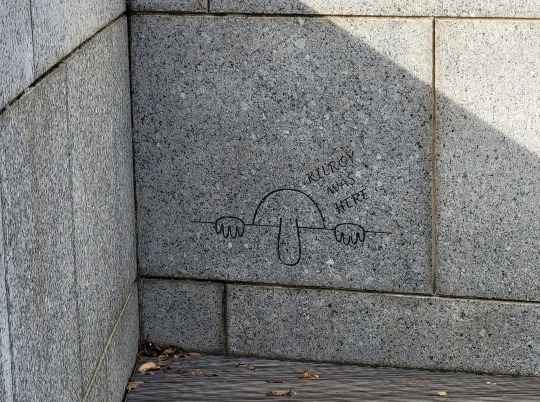
The memorial is stunning! We were questioning the organization of the states and decided to look up the Park Service website to see if we could learn more. This is when we realized that there are 2 "Kilroy was Here" memes etched into the stone.
From the NPS.gov site:
"Kilroy was here”, accompanied by a cartoon drawing of a man looking over a wall, was a popular piece of graffiti drawn by American troops in the Atlantic Theater and then later in the Pacific Theater. It came to be a universal sign that American soldiers had come through an area and left their mark. Eventually, during the war, Kilroy became so popular that this graffiti could be found everywhere. On ship holds, bathrooms, bridges and painted on the shells of Air Force missiles. Its origins most likely come from a British cartoon and the name of an American shipyard inspector. The myths surrounding it are numerous and often center on a German belief that Kilroy was some kind of superspy who could go anywhere he pleased. There are two Kilroy inscriptions hidden in the memorial tucked in the corners of both the Atlantic and Pacific sides of the memorial."
We found both of them after quite a bit of searching! I won't share exactly where they are so you can search them out if you make it to DC as well.
Also, obligatory memorial photos, it really is beautiful.

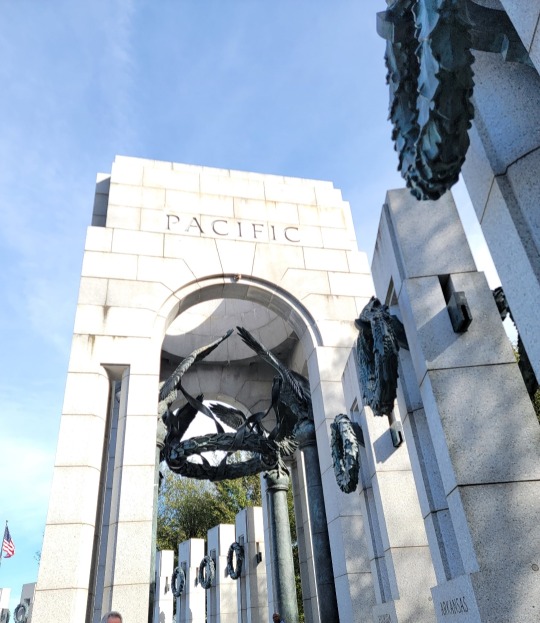



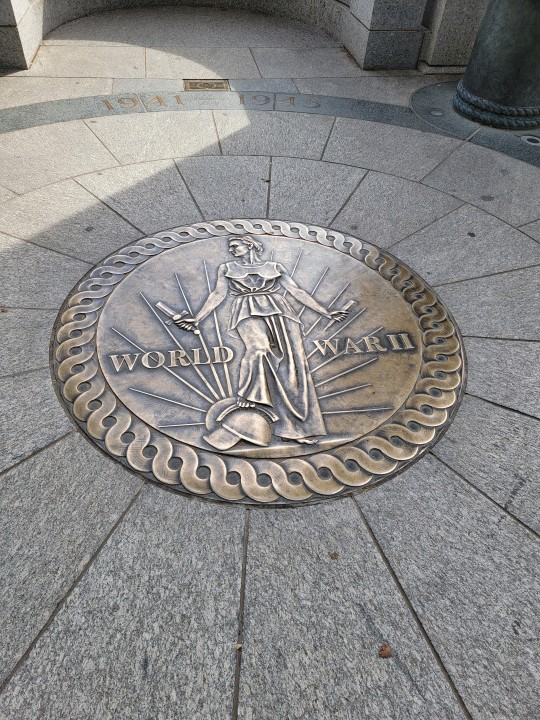



5 notes
·
View notes
Note
i got unbaaaanned here's an ask: can i get a behind the scenes for (one of) your fav/s akekita scene/s you've written, any fic 👀 like, how did the idea come to you, or some fun fact abt the writing process... if you have anything to share ^^
Thank you for this!! I've been dying to have an excuse to talk about this stuff, you have no idea!
This wasn't exactly what you asked, but I thought I'd mention that people who have read my stuff in general point out my use of off-the-wall metaphors/similes. If anyone enjoys my little flair in doing this, I highly recommend reading the works of Peter Beagle! I shamelessly stole the technique from him and made it my own. I recommend starting off with The Last Unicorn (it's a classic for a reason), but any of his older works share a similar style (A Fine and Private Place, Folk of the Air). I'm not sure that I would be a writer today without him.
Anyway...
-Fun fact: Akechi is easier for me to write than Yusuke. I, too, am very angry inside and probably just need a hug lol It's cathartic. Although, two years of studying art in college actually helps with writing Yusuke, because I don't need to look up art terms.
-In Aesopica, the ending was highly inspired by my favorite Tokyo Ghoul fic, in which Kaneki turns the tables on Tsukiyama in the end (huge content warnings for that TG fic btw). I loved how satisfying the circular nature of it was and wanted to try something similar. I knew the ending I wanted to create right from the first chapter.
I cannot remember how I came up with the fruit bowl to both mark the passing of time, and the decay of their relationship. But go past me for coming up with that! My 2017 brain was the real mvp.
This is also my longest fic and you will not see me write anything this long again lol I just don't have it in me. Shout out to long fic writers, I'll have some of whatever you're snacking on.
I also remember this being something of a vent fic. I was sad and wanted to my faves to be sad together. While I do enjoy supportive akekit, where they both grow together, I also love when they just make each other worse.
-Sliced Halves, Light Syrup, please imagine me in the grocery store staring blankly at a can of peaches while concocting an entire fic. Writers are very normal people.
This is also my second most popular akekit fic. Fluff sells, I guess. I prefer my darker stuff tbh!
-After Aesopica, my personal favorite of mine is Psychosomatic. I'm shy about my love of organ-fondling since it's not a common thing to be into (there's not even an official ao3 tag for it lol), so I'm grateful to the person on the kink meme for prompting this. Knowing someone else was interested allowed me to put myself out there and write it. I re-read it not long ago just for fun, and it holds up. It's the intimacy of literally touching the insides of someone, you know?
-I'm scrolling through my akekit fics now and wow! I do not remember some of these? Who wrote these while I wasn't looking??
-Kilroy Was Here was going to be serious angst about Akechi forcibly kissing Yusuke so that he would no longer trust him, because he feels like he doesn't deserve trust, blah, blah... But the idea of Yusuke annoying the crap out of him before they got to that point was so funny to me that I had to run with it. If anyone was wondering about my sense of humor, this fic is it. (I am not funny)
-Born to be Posthumous 69 kudos harr harr... I enjoy this one even if it wasn't as popular as some of my others. I remember being depressed and angry and wanting to take it out on Akechi.
This is getting long now, but it was fun! Thank you again! Hopefully this wasn't too far from you asked! Most of my scenes just come to me as I'm writing with a basic idea in mind, so I just toss them in as I go. A humble chef tossing anything she finds in the fridge right into the soup.
Now that I'm back from my writing hiatus I definitely plan to bring out more akekit when I can!
4 notes
·
View notes
Text
In The Rock 3/11/1983: Styx kick off the ‘Kilroy Was Here’ tour at the Fox Theatre in San Diego. This tour marks the beginning of the end of their most successful era, and demonstrates the limit of Rock fans’ interest in robuts. #Styx #RockHonorRoll

0 notes
Video
youtube
Pontius Pilate in a Different Light: A Little Known Apocryphal Gospel
COMMENTARY:
Pilate created the first offical written record of the Resurrection in his intelligence report to Tiberius that was delivered under a euangelion signals priority. Tertullian cites this euangelion in Book V of his Apology, The euangelion in Mark 1:1 is the harmonization of the contents of Pilate's euangelion as characterized in Tertullian's citation, with the Gospel of Peter, The "Tidings of joy" was the Talking Cross in the vision of the guard mount at the Tomb during Resurrection, LIke Abram in Genesis 15, they are rendered into a swoon and have a collecitve experience of the vision of the process of Resurection and the Ratification of the Covenant Cutting Ceremony between the Hebrew god and the Italian Regiment as represented by Cornelius. From 33 CE, forward, there were Roman soldiers of Christ every where there was a Mithra cult in proximity of a Roman garrison, Everywhere Paul went with Luke, the Roman soldiers of Christ had got there first, in a Kilroy was Here kind of way, The idea that the Gospel of Mark is in any way derivative of Pauline Theology is academic pretzel logic at its best, in a Post Modern Historic Deconstrucion kind of way, The Jesus of Norman Vincet Peale's Prosperity Gospel beloved by business majors and Harvard MBA graduates, universally, The object of the exercise for the gnostic pilgrim is to isolate the Pixie Dust Jesus talught his Disciples to use to heal and repair through the agency over the Spirit of God, Plato's demi-urge in Genesis 1:2. The Plantary FOrce in Forbidden Planent. I believe that Pilate was recalled in 36 CE to report directly to Tiberius and Theophilus of the Praetorian Guards. He wasn't in any danger of discipline, I don't know if Tiberius was aware of the transformation of the Legions into Roman soldiers of Christ, but Theophilus was and hedebriefed Pilate thuroughly and helped him retire in the South of France. The Talking Cross is God's endorsement of the Roman separation of the Stoci from the Epicuriean, the State of the sule of law and the hoi paloi of secular humanism of Jesus.
0 notes
Text
La narcosatánica: El oscuro legado
Una historia de culto, poder y violencia que aún sacude a México. ¿Víctima o villana? La Narcosatánica sigue siendo un misterio. #CrimenOrganizado #HistoriasOscuras #Narcosatanicos
La narcosatánica: Misterios detrás de su macabra historia Índice:¿Quién es Sara Aldrete, la Narcosatánica?El oscuro culto de los NarcosatánicosEl asesinato de Mark Kilroy: El comienzo del fin¿Qué rol jugó realmente Sara Aldrete?Impacto mediático y cultural¿Leyenda o realidad?La narcosatánica: interés y controversia La narcosatánica: Una historia oscura de culto y crimen “La narcosatánica”, nos…
0 notes
Text
La narcosatánica: El oscuro legado
Una historia de culto, poder y violencia que aún sacude a México. ¿Víctima o villana? La Narcosatánica sigue siendo un misterio. #CrimenOrganizado #HistoriasOscuras #Narcosatanicos
La narcosatánica: Misterios detrás de su macabra historia Índice:¿Quién es Sara Aldrete, la Narcosatánica?El oscuro culto de los NarcosatánicosEl asesinato de Mark Kilroy: El comienzo del fin¿Qué rol jugó realmente Sara Aldrete?Impacto mediático y cultural¿Leyenda o realidad?La narcosatánica: interés y controversia La narcosatánica: Una historia oscura de culto y crimen “La narcosatánica”, nos…
0 notes
Text
it's not an april fool i'm like this always
if you knew my true identity (NOT kilroy) you'd go "yeah that tracks"
although then it would likely be "go watch mark of the vampire it's the remake of london after midnight" and NO i have never seen a good review for that ever
0 notes
Text
Mobile Tags! SEASON 2
Ep. 28 Tag: Yetis, Ghosts, Trapped Souls, & Aliens - Haunted Mt. Everest
Episode 28 Link Photodump
Ep. 29 Tag: The Cursed Treasure of Oak Island
Episode 29 Link Photodump
Ep. 30 Tag: The Ritual Sacrifice of Mark Kilroy
Episode 30 Link Photodump
Ep. 30.5 Tag: LISTENER STORIES #4
Episode 30.5 Link Photodump
Ep. 31 Tag: Scratching Fanny, the Ghost of Cock Lane
Episode 31 Link Photodump
Ep. 32 Tag: Roasted Fetuses Dipped in Gold - the Lore Behind Kuman Thong
Episode 32 Link Photodump
Ep. 33 Tag: The Mysterious Disappearance of Lars Mittank
Episode 33 Link Photodump
Ep. 34 Tag: Real Japanese Curses and Urban Legends
Episode 34 Link Photodump
Ep. 35 Tag: Operation Wandering Soul & the Paranormal Side of the Vietnam War
Episode 35 Link Photodump
Ep. 36 Tag: Late Stage Cannibalism Aboard the Doomed Ghost Ship H.M.S. Terror
Episode 36 Link Photodump
Ep. 37 Tag: Indonesian Ghosts During Coronavirus
Episode 37 Link Photodump
Ep. 38 Tag: Charles “The Bewitched” Hapsburg & Inbreeding in the Royal Family
Episode 38 Link Photodump
Ep. 39 Tag: The Kennedy Curse
Episode 39 Link Photodump
Ep. 40 Tag: John Wayne Gacy and his Haunted Artwork
Episode 30 Link Photodump
Ep. 40.5 Tag: LISTENER STORIES #5
Episode 40.5 Link Photodump
Ep. 41 Tag: Randonautica and Mind Matter Interaction (ft. Joshua Lengfelder and Dean Radin)
Episode 41 Link Photodump
Ep. 42 Tag: QAnon, Adrenochrome, and the 5th Dimension
Episode 42 Link Photodump
Ep. 43 Tag: The Happy Valley Dream Survey & The Willamette Valley Dream Survey
Episode 43 Link Photodump
Ep. 44 Tag: The Whaley House
Episode 44 Link Photodump
Ep. 45 Tag: The Pope Lick Monster of Louisville (ft. Steven Suptic)
Episode 45 Link Photodump
Ep. 46 Tag: The Black Death and the Haunting of Poveglia Island
Episode 46 Link Photodump
Ep. 47 Tag: The Murder of the Hammersmith Ghost (ft. Elyse Willems and James Willems)
Episode 47 Link Photodump
Ep. 48 Tag: Anatoly Moskvin’s Black Magic Dolls (ft. Cib and Sami Jo)
Episode 48 Link Photodump
Ep. 49 Tag: Who Put Bella in the Wych Elm? (ft. Steve Zaragoza)
Episode 49 Link Photodump
Ep. 50 Tag: Filipino Folklore (ft. Sapphire Sandalo)
Episode 50 Link Photodump
Ep. 50.5 Tag: LISTENER STORIES #6
Episode 50.5 Link Photodump
Ep. 51 Tag: Lake City Quiet Pills
Episode 51 Link Photodump
Ep. 52 Tag: The Dibbuk Box
Episode 52 Link Photodump
Ep. 53 Tag: The Curse of Malaysia Airlines Flight 370
Episode 53 Link Photodump
Ep. 54 Tag: The Andes Flight Disaster
Episode 54 Link Photodump
Ep. 55 Tag: The Ritual Murder of Pastor Carol Daniels
Episode 55 Link Photodump
BONUS Q&A Season 2 Finale
Episode Link Photodump
1 note
·
View note
Text
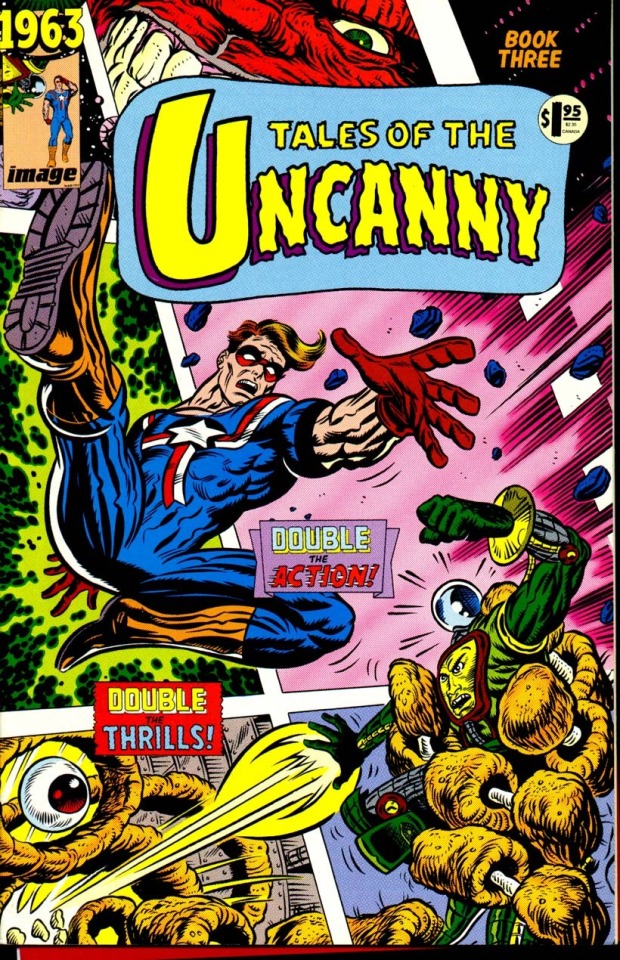
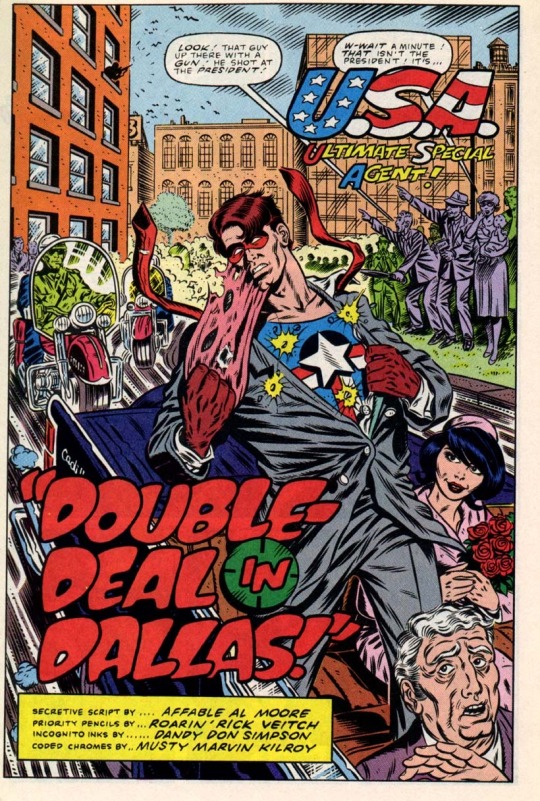
IMAGE COMICS PRESENTS: FROM THE PAGES OF 1963! THE UNCANNIEST TALES EVER TOLD!
PIC(S) INFO: Introducing U.S.A., a.k.a., Ultimate Special Agent, the Hypernaut, Queep!, Red Brain, & more! -- Spotlight on cover art (and opening splash page) to "1963: Vol.1 -- Book Three: Tales of the Uncanny." June, 1993. Image Comics.
Secretive script by "Affable" Al Moore
Priority pencils by "Roarin'" Rick Veitch
Incognito inks by "Dandy" Don Simpson
Coded chromes by "Musty" Mark Kilroy
Source: https://comiconlinefree.net/1963/issue-3.
#1963 Vol.1#Ultimate Special Agent#U.S.A.#1963#1963 Image Comics 30#1963 Comics 30#1963 Comic Book Series#Red Brain#Rick Veitch Art#Rick Veitch#1963: Tales of the Uncanny#Sci-fi#Sci-fi Art#Image Comics#Hypernaut#Tales of the Uncanny Vol. 1#1963 Comics#Alan Moore#Tales of the Uncanny#1990s#JFK#Comics#Splash page#Sci-fi Fri#The Hypernaut#Cover Art#1963: Tales of the Uncanny Vol. 1#1993
0 notes
Note
The murder of Mark Kilroy has two suspects still missing!
@yapperz-universe @oakthefrog
I dare you to ramble about your favorite topic, then ping 5 of your moots, who will also have to do this
uh i like dick sm
@novastaronline @turquitheslimeplush @kuruka1559s @th3-r4t-48 @6arely-living
61 notes
·
View notes
Text
Regardless of how low a person stoops, it is never too late to uncover a redemptive epiphany. Can I mine an inspirational ray of motivation from my darkest thoughts that allows me to confront the commonplace disorders and tragic interruptions of life? What physical, mental, and emotional strumming make up the tinderbox that produces the moral tension that gives meaning to the life of an ordinary person? Amongst the chaos, confusion, and compromises that mark existence, how do we go about understanding ourselves? How do we become in touch with our personal band of raw emotions? Does self-transformation commence by admitting illicit impulses, irrational thoughts, disturbing habits, mythic misgivings, and stinted worldview? Do we learn through deconstructing our maverick experiences or through intellectual abstraction? In order to move forward in life, is it sometimes necessary to dissect ourselves? Would it prove helpful systematically to take apart nightmarish experiences that seemly never let go of a person?
Kilroy J. Oldster
35 notes
·
View notes
Text
Borderland is a 2007 film loosely based on Constanzo and his cult from Episode Thirty: The Ritual Sacrifice of Mark Kilroy.









RIDER STRONG as PHIL in BORDERLAND (2007)
16 notes
·
View notes
Photo
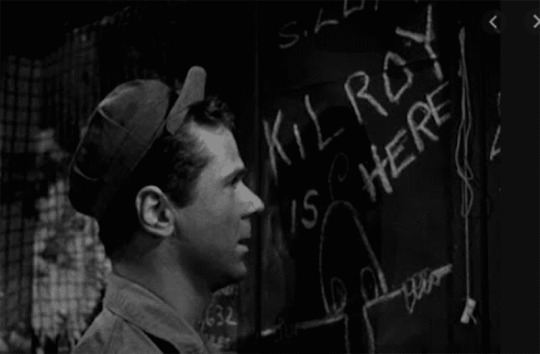
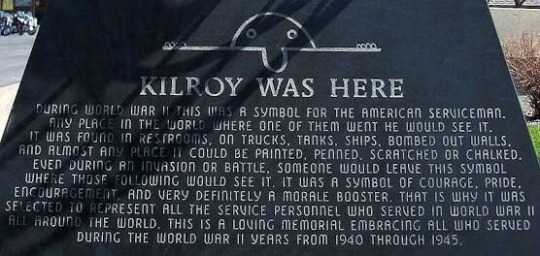
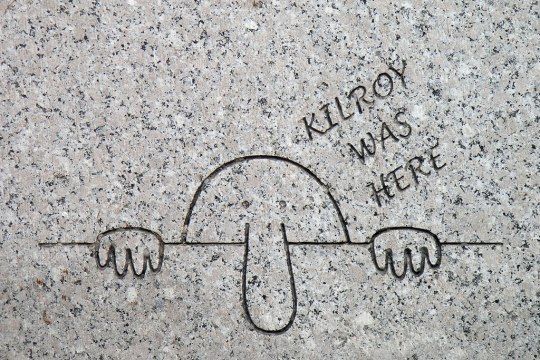

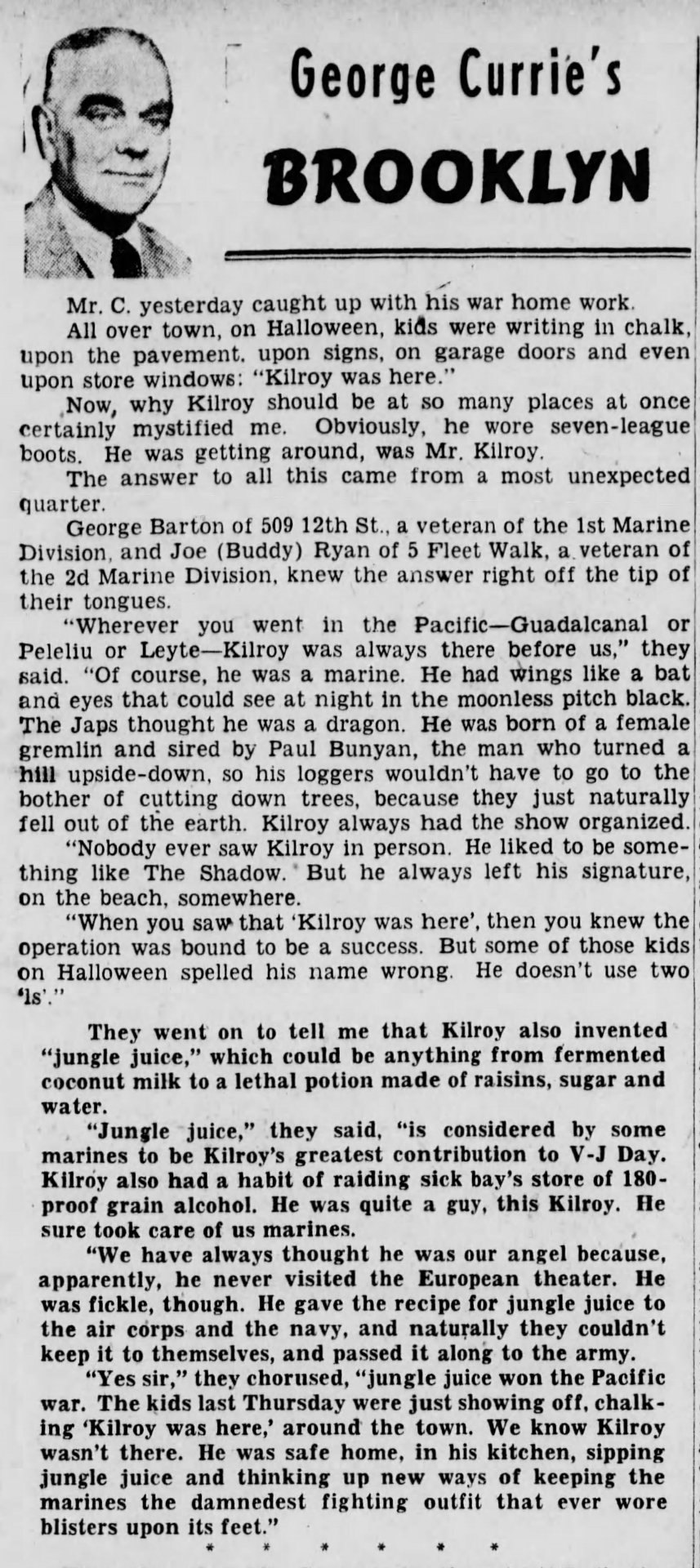
“Kilroy Was Here”
Want a cultural reference that Steve and Bucky would, 100% be familiar with? Kilroy is it — A long-nosed, bald figure, peeking over a wall accompanied by the words “Kilroy was here.”
This little doodle and quote is associated with World War II GIs, and over the course of the war could be found everywhere US soldiers passed through. Building walls, weaponry, bombed out ruins, barracks, canvases, vehicles and aircraft...any flat surface was fair game. To millions of military personal throughout the war, it was a legendary sight.
Why?
In the simplest terms, it was cheap and easy entertainment in the face of war. It was a morale booster, an emblem of pride, a challenge, an Allied rally cry, and a mark of progress. “When you saw that ‘Kilroy was here’, then you knew the operation was bound to be a success.”
Precursors
This strange little calling card did not spring up fully formed from nothing, it in-fact had two key forerunners.
“Foo was here” During World War I, the First Australian Imperial Force (1st AIF) left “Foo was here” along with a familiar long-nosed figure peering over a wall, chalked on the side of railway carriages. “Foo” is assumed to have been an acronym for Forward Observation Officer (officer responsible for directing artillery and mortar ).
Mr Chad A similar doodle could be found through Britain from 1938, as a commentary on wartime rationing and shortages. Mr Chad would be accompanied by messages following the template of “Wot? No [blank]?” — “Wot? No Tea?” “Wot? No Bread?”. The figure itself was potentially based on the Greek Omega symbol, or a simplified impression of a circuit diagram.
I have no doubt that the boys, along with the Howling Commandos would have been familiar with the imagery. I personally love the headcanon of defrosted Steve or Post-WS Bucky absently doodling Kilroy on paperwork, napkins, or scrap-paper, the same way kids in the 90′s drew than dang “Cool S” on everything.
If you want more in the topic, my full research notes on all topics are available for all $3+ Patreon patrons!
Image Sources
Still from film “Kilroy Was Here”, 1947 | Source Kilroy Was Here Marker, Neilsville, Wisconsin, 1993 | Source Kilroy engraving on the National WWII Memorial, Washington, D.C. | Source Kilroy on aircraft, c.1944-45 | Source — Photographer: Dick Bastasch Brooklyn Daily Eagle Article, 3 Nov 1946, page 3 | Source

This post has been sponsored by my much loved and long-time Patreon supporter Joanna Daniels. She and I would like to dedicate the post to the loving memory of her mother Joan Daniels. She will be sorely missed.

[ Support SRNY through Patreon and Ko-Fi ] And join us on Discord for fun conversation! I also have an Etsy with up-cycled nerdy crafts
#Steve Rogers#Bucky Barnes#Howling Commandos#Kilroy#Kilroy was here#WWII#World War II#US Military#History#1940s#1930s#Wartime#captain america#Captain America: The First Avenger#CAPTAIN AMERICA REFERENCE#fanfiction#fanfic#fanfic writing#Fanfic references#fanfic research#writing#writing resources#writing reference#fan fic writing#historically accurate#historically accurate steve rogers#historically accurate bucky barnes#Allied Forces#ca:tfa#Marvel
181 notes
·
View notes